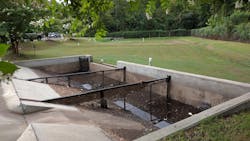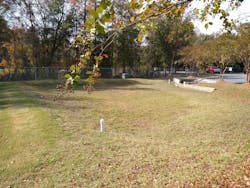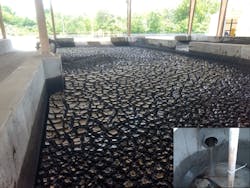Fighting pathogen growth in industrial stormwater with ESCS
As urban areas expand into more industrial areas, stormwater runoff may be increasingly at risk of being contaminated by chemicals, heavy metals, sediments and other pollutants. If not managed and treated appropriately, stormwater can adversely affect the quality of water sources, damage property and harm local ecosystems.
To minimize pollutant discharge and protect water quality, facility managers and owners work with local water quality authorities and the National Pollutant Discharge Elimination System (NPDES), a facet of the U.S. Environmental Protection Agency’s (EPA) Clean Water Act, to establish best management practices (BMP) by developing stormwater pollution prevention plans (SWPPPs). Efficient prevention practices include identifying potential pollution sources at industrial sites and devising different strategies to control and mitigate their release. Recommended measures for pollutants include the installation of erosion control measures, sediment basins, filtration systems or vegetative buffers to prevent or reduce the transport of pollutants in stormwater runoff. Expanded shale, clay or slate (ESCS) is a great medium for all these green infrastructure applications.
Sustainable & Economical Stormwater Treatment Solutions with ESCS
The foundational idea among these practices is to treat polluted stormwater before discharging. While hydro-industrial filters can be expensive for larger applications, low-impact filtration techniques to remove total suspended solids (TSS), nutrients and heavy metals can be the first line of treatment. To facilitate this, surface water and erosion control professionals can rely on economical, green infrastructure techniques like biofilters and permeable plots. Biofilters are recessed strips of land around industrial facilities that can hold and filter stormwater runoff. Likewise, permeable surfaces including parking plots with permeable pavers can capture, store and filter the first flush of polluted runoff. In these applications, ESCS can serve as efficient filtration media due to its unconnected network of pores. Dimensionally stable and environmentally inert, ESCS is capable of absorbing and retaining large amounts of phosphorus and heavy metal from industrial stormwater runoff.
ESCS Reduces Heavy Metal from Industrial Stormwater
Industrial stormwater runoff typically has high concentrations of copper, zinc and lead, which can have toxic effects on the receiving bodies of water. The removal of these impurities can be challenging especially when varying hydraulic retention time (HRT) — the average amount of time the stormwater remains in a basin during the wastewater treatment process — is low. This can reduce polluted water’s contact time with filtration devices and its pollutant removal efficiency.
Biofilters amended with ESCS adsorb and filter water through the aggregate’s network of pores. ESCS initiates sedimentation of solid substances from the runoff. In addition to that, research experiments published in the “Journal of Hazardous Materials” suggest that even with low HRT, ESCS can remove heavy metals from contaminated water through adsorption. The metal compounds bind strongly to ESCS, allowing the water to percolate through the biofilter into the next step in the treatment line. Although other soil amendments like peat, compost, fly ash or zeolite have shown the capacity to remove heavy metals, research shows that ESCS exhibits a higher metal removal capacity. ESCS’ capacity for removal increases as the HRT increases, so biofilters amended with ESCS that have a high HRT can remove more metals due to the aggregate’s effective adsorption capacity and added time. Not only does this limit the leaching of metals into filtered stormwater, but ESCS-adsorbed metals can contribute to eliminating other harmful elements of runoff.
Adsorbed Metal in ESCS Decapacitates Pathogens
Solid impurities and heavy metals are not the only concerning elements in industrial stormwater. The runoff may also contain pathogens and bacteria like E. coli that can infect human intestinal systems if consumed. By changing the surface properties of ESCS, heavy metals increase the material’s capacity to absorb E. coli. So, ESCS uses the already present heavy metals from the stormwater to deactivate pathogens.
When introduced to heavy metals, ESCS’ E. coli removal capacity increases as the material ages. Other materials tend to lose the capacity to remove harmful solids from runoff over time—research suggests exposure, the growth of biofilms and absorption of natural organic material can limit the media’s service life to 15 to 20 years. Because ESCS’ filtration capacities have the potential to increase with time, it can provide a long-term pollutant reduction of industrial stormwater runoff. This, in turn, helps industrial filtration projects meet EPA standards year-after-year with lower maintenance requirements.
Efficient Inactivation of Pathogens
For typical sand/soil/gravel media, adsorbed pathogens in the system may remobilize since the media cannot deactivate them on its own. To facilitate inactivation, facility managers may mix silver, copper or other antimicrobial metal nanoparticles with media. However, these measures are uneconomical for large-scale applications and may not improve results significantly. In contrast, ESCS aggregates can develop an antibacterial coating by adsorbing metals naturally present in stormwater. This allows the medium to significantly reduce or eliminate the remobilization of pathogens.
Another challenge with pathogens is to ensure that they are not released during the intermittent flow of water. Amendments such as biochar or iron filings are known to improve removal. But they are not a long-term solution as aging of these media could lower pathogen removal and in turn, can make the biofilter a source of pathogens. Test results for aged ESCS demonstrated that heavy metal adsorption also reduced the remobilization of adsorbed E. coli during intermittent infiltration of stormwater. This way, biofilters amended with ESCS harness effective solutions by not only initiating sedimentation of total suspended solids from the runoff but also using a pollutant (heavy metals) in the stormwater to treat the pathogens and bacteria. This capacity only becomes more effective with time.
Optimizing Water Treatment Practices with ESCS
By embracing ESCS-amended biofilters, surface water and erosion control professionals can enhance the performance of stormwater management practices while protecting surface water quality. These biofilters can be strategically implemented at critical locations within stormwater systems to target mixed pollutants, including heavy metals and pathogens. This proactive and economical approach enables professionals to minimize pollutant discharges, improve water quality, mitigate the potential risks posed by stormwater runoff and promote sustainable stormwater management practices.
Debbie Stringer
Debbie Stringer has worked in the North Carolina green industry for 36 years and received her horticulture degree at SCC Program in Pinehurst NC (‘97). Carolina Stalite Company hired Debbie in 1999 to promote ESCS to the green industry where her responsibilities broadened to include filtration for stormwater and wastewater; she is certified as a NC BMP Inspection and Maintenance Technician and stays current with stormwater trends through NCSU-BAE and NC-DEQ continuing education.








